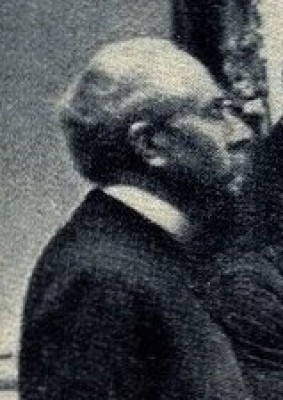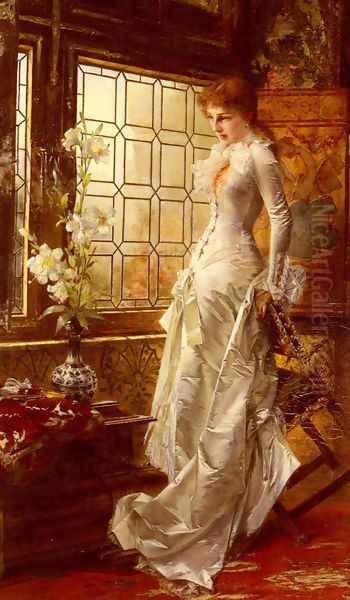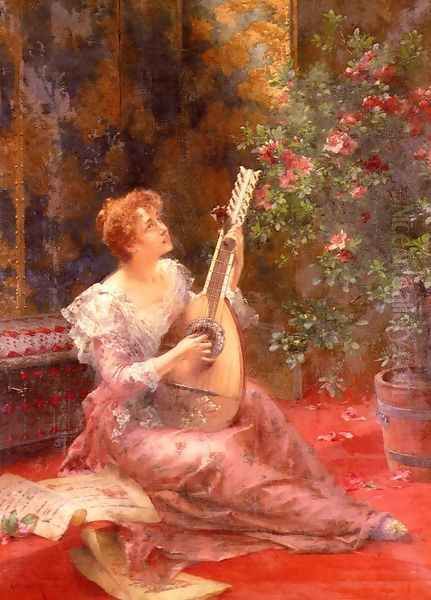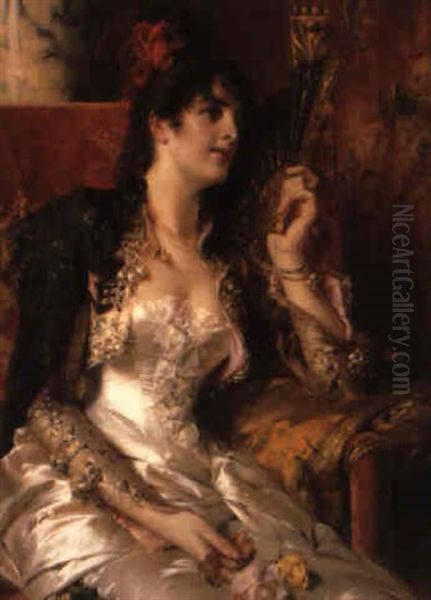
Conrad Kiesel stands as a significant, albeit sometimes overlooked, figure in the landscape of 19th-century German art. Active during a period of immense social and artistic change, Kiesel carved a niche for himself primarily as a painter, though his early training included architecture and sculpture. He became renowned for his sensitive and elegant portrayals of women, capturing both their external beauty and a sense of their inner lives against the backdrop of an evolving modern world. His work, rooted in Realism yet touched by Romantic sensibilities, earned him considerable acclaim during his lifetime, including prestigious awards and commissions.
Born in Düsseldorf in 1846, a city already famous for its influential art academy (the Düsseldorf School of Painting), Kiesel's initial artistic inclinations led him towards architecture. He pursued these studies formally in Berlin at the Royal Building Academy. This foundational training likely instilled in him a strong sense of structure and composition, elements that would subtly inform his later pictorial work. However, his path soon diverged.
Early Training and Transition to Painting
Alongside his architectural studies, Kiesel explored the three-dimensional form through sculpture, training with the notable sculptor Fritz Schaper. Schaper himself was a prominent figure, known for his monuments and portrait busts, representing the academic tradition in Berlin. This engagement with sculpture provided Kiesel with a deep understanding of human anatomy and form, crucial for any figurative artist.
The decisive shift towards painting occurred after this initial grounding in architecture and sculpture. Seeking to master the nuances of color and texture, particularly the challenging art of rendering fabrics convincingly, Kiesel sought instruction from Wilhelm Sohn (sometimes spelled Sonn). Sohn, a respected professor associated with the Düsseldorf School, was known for his genre scenes and portraits, often characterized by meticulous detail and rich coloration. Under Sohn's guidance, Kiesel honed the technical skills that would become hallmarks of his mature style.

After a period that included travels, possibly including a visit to the Netherlands which might have exposed him to the Dutch Masters' handling of light and interiors, Kiesel eventually settled. While born in Düsseldorf and influenced by Sohn, Berlin became the primary center for his professional career. He established himself there as both a portrait and genre painter, though he never entirely abandoned his identity as a sculptor. This dual expertise perhaps contributed to the tangible, almost sculptural quality found in some of his painted figures.
Development of a Signature Style
Kiesel's artistic reputation rests firmly on his depictions of women, particularly young, elegant figures often shown in moments of quiet contemplation or leisure within refined interior settings. His style is best characterized as a sophisticated blend of Realism and a lingering Romanticism. The Realism is evident in the meticulous attention to detail – the precise rendering of luxurious fabrics like silk and satin, the accurate depiction of jewelry, furniture, and the play of light on surfaces.
He possessed a remarkable ability to capture the delicate textures of skin, often employing what has been described as a "fading brushstroke technique" – perhaps akin to a subtle sfumato or blending – which allowed skin tones to transition smoothly and appear lifelike under varying light conditions. This technical finesse avoided harsh lines, contributing to the overall softness and grace of his subjects.
The Romantic element manifests in the mood and sensibility of his paintings. His subjects often possess an air of gentle melancholy, introspection, or dreamy repose. While realistically depicted, they transcend mere photographic likeness to evoke an emotional response. Kiesel seemed less interested in dramatic narratives and more focused on capturing a specific atmosphere or the psychological presence of the individual. His use of color, often involving sophisticated harmonies and contrasts between warm and cool tones, further enhanced the dramatic or poetic effect of his compositions.
Themes and Subject Matter: The Elegant Woman
The recurring motif in Kiesel's oeuvre is the modern woman of the late 19th and early 20th centuries, often associated with the ideals of the Belle Époque. His subjects are typically portrayed in fashionable attire, surrounded by objects suggesting taste and refinement – musical instruments, fans, flowers, books, elegant furnishings. These are not merely decorative elements; they contribute to the characterization of the sitter and the overall narrative of the scene, however subtle.

Kiesel's women often appear poised and self-possessed, embodying a blend of traditional femininity with an emerging modern sensibility. They might be shown reading, playing music, arranging flowers, or simply gazing out of a window, lost in thought. Works like At the Window exemplify this theme, where the window acts as a threshold between the private interior world of the subject and the external world, inviting contemplation on her thoughts and feelings.
His focus was not just on idealized beauty but on conveying a sense of personality and inner life. The delicate rendering of facial expressions, the posture of the body, and the interaction of the figure with her environment all contribute to this psychological depth. In this respect, Kiesel's work reflects the broader societal interest in individuality and interiority that characterized the late 19th century, moving beyond purely representational portraiture towards a more nuanced exploration of the human subject.
Notable Works
Several paintings stand out as representative of Conrad Kiesel's style and thematic concerns. The Lute Player showcases his skill in rendering textures – the sheen of the instrument, the richness of the fabrics worn by the musician – and captures a moment of quiet artistic absorption. The composition is balanced, the lighting soft, focusing attention on the elegant figure and her connection to the music.
Señorita with a Fan presents a different facet, perhaps hinting at a more coquettish or worldly character through the subject's direct gaze and the symbolic accessory of the fan. Again, the meticulous detail in the costume and the sensitive handling of the figure's features are paramount. The painting demonstrates Kiesel's ability to adapt his approach to suit the perceived personality of his sitter.
At the Window, as previously mentioned, is a quintessential Kiesel theme. The subject, often a young woman, is positioned near a window, bathed in natural light. This setting allows for complex plays of light and shadow and creates a poignant mood of contemplation or longing. The view outside, if visible, often contrasts with the intimate interior space. These works highlight Kiesel's mastery of light and atmosphere.
Beyond these specific titles, numerous portraits and genre scenes featuring elegant women in interiors populate his body of work. A painting described as being in the Belle Époque style, potentially referring to a specific work handled by galleries like SOUZA (as mentioned in source material research), would likely fit seamlessly within this dominant theme, characterized by its grace, refinement, and reflection of the era's aesthetic ideals.
Recognition and Career Success

During his lifetime, Conrad Kiesel achieved significant recognition within the German and international art worlds. His technical skill and appealing subject matter found favor with both critics and the public. He regularly exhibited his paintings, particularly at the prestigious Berlin Academy exhibitions, where his work was frequently awarded gold medals, signifying high official approval.
His reputation extended beyond Berlin. He also participated in major exhibitions in Munich, another key center for German art at the time. Crucially, Kiesel gained international exposure. He exhibited at the Paris Exposition Universelle (World's Fair) of 1900, a major global event showcasing achievements in arts and industry, where he received an honorable mention. He also showed works at international exhibitions in Rome in 1909 and 1911.
A significant mark of his standing was receiving a commission to paint a portrait of Emperor Wilhelm II. Portraiture of royalty and high-ranking officials was a prestigious undertaking, often reserved for artists held in high esteem. Successfully navigating the expectations of such commissions required not only artistic skill but also diplomatic acumen. Following this, Kiesel was granted the title of Honorary Professor by the Berlin Academy of Arts, cementing his position within the official art establishment of Wilhelmine Germany.
Context within German Art
To fully appreciate Conrad Kiesel's contribution, it's helpful to place him within the vibrant and diverse art scene of 19th-century Germany. Born in Düsseldorf, he emerged from a milieu dominated by the Düsseldorf School, known for its detailed narrative paintings and landscapes, with artists like Andreas Achenbach and Oswald Achenbach being prominent figures. Kiesel's teacher, Wilhelm Sohn, was part of this tradition, emphasizing meticulous technique.
However, Kiesel's career largely unfolded in Berlin, which by the late 19th century had become a major artistic hub rivaling Munich. Here, the art world was complex. The official taste, represented by the Academy and figures like Anton von Werner (known for his grand historical paintings, particularly of Prussian military and state events), favored academic realism and historical subjects. Kiesel's work, with its polish and realism, aligned comfortably with these academic standards, explaining his success in official exhibitions and the imperial commission.
At the same time, German Realism was exploring different avenues. Adolph Menzel, also based in Berlin, was a towering figure known for his unsparingly realistic depictions of historical scenes (like Frederick the Great's court) and contemporary life, rendered with virtuosic draughtsmanship. In Munich, Wilhelm Leibl and his circle pursued a form of realism focused on peasant life and portraiture, characterized by direct observation and often painterly techniques, influenced by Courbet. Kiesel's realism was generally more refined and idealized than that of Menzel or Leibl, focusing on bourgeois or aristocratic elegance.
Franz von Lenbach, another highly successful contemporary, specialized in portraiture, particularly of prominent figures like Bismarck, often employing a darker palette and a more dramatic, Rembrandtesque lighting style than Kiesel. Further afield, the opulent, decorative historical and allegorical paintings of the Austrian Hans Makart represented another facet of late 19th-century taste, sharing perhaps a love for rich textures with Kiesel, but on a grander scale. Similarly, Anselm Feuerbach pursued classically inspired themes with a certain melancholic grandeur.
As Kiesel's career progressed into the late 19th and early 20th centuries, new movements began to challenge the academic establishment. German Impressionism emerged with leading figures like Max Liebermann, Lovis Corinth, and Max Slevogt, who often broke away from the academies to form Secession movements (like the Berlin Secession, founded in 1898). Their work featured looser brushwork, brighter palettes, and a focus on capturing fleeting moments and the effects of light, differing significantly from Kiesel's more polished finish. While Kiesel remained successful within the established structures, his style represented the tradition against which these newer movements were reacting. Earlier German Romanticism, exemplified by Caspar David Friedrich or Ludwig Richter, while chronologically distant, might be seen as a faint echo in the mood and sensitivity of some of Kiesel's works, albeit translated into a realist idiom.
The Controversial Quote and Artistic Philosophy
A quote attributed to Conrad Kiesel offers insight into his intense dedication but also sparked controversy: "Nobody can be a painter unless he loves painting more than anything else." This statement, absolute and uncompromising, clearly reflects a deep personal commitment to his art form. It suggests that for Kiesel, painting was not merely a profession but a consuming passion, demanding total devotion above all other aspects of life.
While admirable in its expression of artistic dedication, the quote was perceived by some as arrogant or overly narrow. Critics might argue that life, love, freedom, or other human values are equally, if not more, important than art. The statement raises questions about the relationship between art and life, and the potential for artistic obsession to overshadow other human experiences. Regardless of its reception, the quote underscores the seriousness with which Kiesel approached his craft and his belief in the supreme importance of artistic endeavor. It paints a picture of an artist wholly invested in the pursuit of painterly excellence.
Later Reputation and Reassessment
Despite the considerable success and recognition Conrad Kiesel enjoyed during his lifetime, his reputation experienced a decline in the decades following his death in 1921. The early and mid-20th century saw the triumphant rise of Modernism, with movements like Expressionism (e.g., Die Brücke, Der Blaue Reiter in Germany), Cubism, Surrealism, and Abstract Expressionism dominating critical discourse and museum acquisitions.
In this context, Kiesel's art, with its adherence to academic realism, detailed finish, and focus on conventional beauty, came to be seen by many proponents of Modernism as conservative, sentimental, or simply outmoded. The emphasis shifted towards formal innovation, subjective expression, abstraction, and social critique – qualities less evident in Kiesel's elegant portrayals. His work, along with that of many other successful academic painters of the 19th century, was largely marginalized or dismissed as merely illustrative or decorative.
However, beginning in the later 20th century, particularly from the 1970s and 1980s onwards, there has been a gradual reassessment of 19th-century academic art. Art historians began to look beyond the modernist narrative and re-evaluate these artists on their own terms. The rise of feminist art history also played a role, prompting new interpretations of depictions of women. Kiesel's work began to be reconsidered, not just for its technical skill, but for its cultural significance.
Some interpretations now view his paintings as more than just aesthetically pleasing objects. They are seen as reflecting the complexities of female identity during a period of transition, capturing a specific socio-cultural moment. The idea that his work might serve as a form of "visual testimony of existentialism," as suggested in some analyses derived from the source material, points towards interpretations that find deeper layers of meaning related to individual existence, introspection, and the human condition within his seemingly serene portraits. This renewed interest has helped restore Kiesel's place as a noteworthy artist of his time.
Legacy and Conclusion
Conrad Kiesel occupies a distinct place in the history of German art. He was a master technician, skilled in both painting and sculpture, who chose to dedicate his mature career primarily to the depiction of feminine grace and elegance. His work exemplifies the high level of craftsmanship achieved within the academic tradition of the late 19th century, particularly in the meticulous rendering of textures, fabrics, and the subtle nuances of human features and expressions.
While not an innovator in the sense of radically challenging artistic conventions like the Impressionists or later Modernists, Kiesel excelled within his chosen idiom. He created a body of work characterized by its refinement, sensitivity, and quiet psychological depth. His paintings offer a window into the aesthetic ideals and social milieu of the Belle Époque, particularly concerning the representation of women.
His success during his lifetime, marked by awards, prestigious commissions like the Emperor's portrait, and international exhibitions, attests to his contemporary significance. Though his reputation waned during the height of Modernism, the later reassessment of 19th-century art has allowed for a more balanced appreciation of his contributions. Conrad Kiesel remains an important figure for understanding the complexities of German art in the transition period leading into the 20th century, an artist who skillfully blended realistic depiction with a subtle romantic sensibility to create enduring images of feminine beauty and introspection. His dedication to his craft, encapsulated in his controversial quote, speaks to the profound commitment that underlies his polished and evocative paintings.